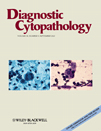Metastatic peritoneal mesothelioma in the setting of recurrent ascites: A case report
Corresponding Author
Von Samedi M.D., Ph.D.
Department of Pathology, Beth Israel Deaconess Medical Center, Harvard University, Boston, Massachusetts
Department of Pathology, Beth Israel Deaconess Medical Center, 330 Brookline Ave, East Campus, Boston, MA 02215-5400Search for more papers by this authorSherrie White M.D.
Department of Pathology, Beth Israel Deaconess Medical Center, Harvard University, Boston, Massachusetts
Search for more papers by this authorMary Jane Zimarowski M.D.
Department of Pathology, Beth Israel Deaconess Medical Center, Harvard University, Boston, Massachusetts
Search for more papers by this authorAnna Harris M.D.
Department of Pathology, Beth Israel Deaconess Medical Center, Harvard University, Boston, Massachusetts
Search for more papers by this authorJeffrey Saffitz M.D., Ph.D.
Department of Pathology, Beth Israel Deaconess Medical Center, Harvard University, Boston, Massachusetts
Search for more papers by this authorHelen H. Wang M.D., Dr.Ph.
Department of Pathology, Beth Israel Deaconess Medical Center, Harvard University, Boston, Massachusetts
Search for more papers by this authorCorresponding Author
Von Samedi M.D., Ph.D.
Department of Pathology, Beth Israel Deaconess Medical Center, Harvard University, Boston, Massachusetts
Department of Pathology, Beth Israel Deaconess Medical Center, 330 Brookline Ave, East Campus, Boston, MA 02215-5400Search for more papers by this authorSherrie White M.D.
Department of Pathology, Beth Israel Deaconess Medical Center, Harvard University, Boston, Massachusetts
Search for more papers by this authorMary Jane Zimarowski M.D.
Department of Pathology, Beth Israel Deaconess Medical Center, Harvard University, Boston, Massachusetts
Search for more papers by this authorAnna Harris M.D.
Department of Pathology, Beth Israel Deaconess Medical Center, Harvard University, Boston, Massachusetts
Search for more papers by this authorJeffrey Saffitz M.D., Ph.D.
Department of Pathology, Beth Israel Deaconess Medical Center, Harvard University, Boston, Massachusetts
Search for more papers by this authorHelen H. Wang M.D., Dr.Ph.
Department of Pathology, Beth Israel Deaconess Medical Center, Harvard University, Boston, Massachusetts
Search for more papers by this authorAbstract
Malignant peritoneal mesothelioma is uncommon but rapidly fatal with a median survival of less than 1 year. The diagnosis of this entity is often delayed because of the nonspecific presenting symptoms and nonspecific cytological features of the mesothelial cells in the peritoneal fluids.
A 72-year-old man who had no known history of exposure to asbestos and had longstanding refractory ascites thought to be secondary to alcoholic cirrhosis was found to have widespread metastatic malignant mesothelioma involving the lung, liver, pancreas, peritoneal, and pelvic wall, skin and subcutaneous tissue. Diagn. Cytopathol. 2010;38:675–681. © 2009 Wiley-Liss, Inc.
References
- 1 Antman K,Shemin R,Ryan L, et al. Malignant mesothelioma: Prognostic variables in a registry of 180 patients, the Dana-Farber Cancer Institute and Brigham and Women's Hospital experience over two decades, 1965–1985. J Clin Oncol 1988; 6: 147–153.
- 2 Boffetta P. Epidemiology of peritoneal mesothelioma: A review. Ann Oncol 2007; 18: 985–990.
- 3 National Cancer Institute. Surveillance, epidemiology and end results (SEER) program. Available at http://www.seer.cancer.gov. National Cancer Institute. Accessed April 2009.
- 4 Carbone M,Bedrossian CW. The pathogenesis of mesothelioma. Semin Diagn Pathol 2006; 23: 56–60.
- 5 Mohamed F,Sugarbaker PH. Peritoneal mesothelioma. Curr Treat Options Oncol 2002; 3: 375–386.
- 6 Attanoos RL,Griffin A,Gibbs AR. The use of immunohistochemistry in distinguishing reactive from neoplastic mesothelium. A novel use for desmin and comparative evaluation with epithelial membrane antigen, p53, platelet-derived growth factor-receptor, P-glycoprotein and Bcl-2. Histopathology 2003; 43: 231–238.
- 7 Saad RS,Cho P,Liu YL,Silverman JF. The value of epithelial membrane antigen expression in separating benign mesothelial proliferation from malignant mesothelioma: A comparative study. Diagn Cytopathol 2005; 32: 156–159.
- 8 Shen J,Pinkus GS,Deshpande V,Cibas ES. Usefulness of EMA. GLUT-1, and XIAP for the cytologic diagnosis of malignant mesothelioma in body cavity fluids. Am J Clin Pathol 2009; 131: 516–523.
- 9 Kato Y,Tsuta K,Seki K, et al. Immunohistochemical detection of GLUT-1 can discriminate between reactive mesothelium and malignant mesothelioma. Mod Pathol 2007; 20: 215–220.
- 10 Hanley KZ,Facik MS,Bourne PA, et al. Utility of anti-L523S antibody in the diagnosis of benign and malignant serous effusions. Cancer 2008; 114: 49–56.
- 11 Mueller F,Bommer M,Lacher U, et al. KOC is a novel molecular indicator of malignancy. Br J Cancer 2003; 88: 699–701.
- 12 Björkqvist AM,Tammilehto L,Anttila S,Mattson K,Knuutila S. Recurrent DNA copy number changes in 1q, 4q, 6q, 9p, 13q, 14q and 22q detected by comparative genomic hybridization in malignant mesothelioma. Br J Cancer 1997; 75: 523–527.
- 13 Onofre FB,Onofre AS,Pomjanski N,Buckstegge B,Grote HJ,Bocking A. 9p21 Deletion in the diagnosis of malignant mesothelioma in serous effusions additional to immunocytochemistry. DNA-ICM, and AgNOR analysis. Cancer 2008; 114: 204–215.
- 14 Sandberg AA,Bridge JA. Updates on the cytogenetics and molecular genetics of bone and soft tissue tumors. Mesothelioma Cancer Genet Cytogenet 2001; 127: 93–110.
- 15 Chiosea S,Krasinskas A,Cagle PT,Mitchell KA,Zander DS,Dacic S. Diagnostic importance of 9p21 homozygous deletion in malignant mesotheliomas. Mod Pathol 2008; 21: 742–747.
- 16 King JE,Thatcher N,Pickering CA,Hasleton PS. Sensitivity and specificity of immunohistochemical markers used in the diagnosis of epithelioid mesothelioma: a detailed systematic analysis using published data. Histopathology 2006; 48: 223–232.
- 17 Politi E,Kandaraki C,Apostolopoulou C,Kyritsi T,Koutselini H. Immunocytochemical panel for distinguishing between carcinoma and reactive mesothelial cells in body cavity fluids. Diagn Cytopathol 2005; 32: 151–155.
- 18 Roberts F,Harper CM,Downie I,Burnett RA. Immunohistochemical analysis still has a limited role in the diagnosis of malignant mesothelioma. A study of thirteen antibodies. Am J Clin Pathol 2001; 116: 253–262.
- 19 Robinson BW,Creaney J,Lake R, et al. Mesothelin-family proteins and diagnosis of mesothelioma. Lancet 2003; 362: 1612–1616.
- 20 Brigand C,Monneuse O,Mohamed F, et al. Peritoneal mesothelioma treated by cytoreductive surgery and intraperitoneal hyperthermic chemotherapy: results of a prospective study. Ann Surg Oncol 2006; 13: 405–412.




